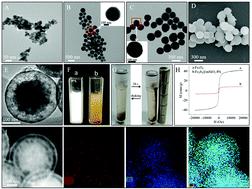当前位置:
X-MOL 学术
›
Biomater. Sci.
›
论文详情
Our official English website, www.x-mol.net, welcomes your
feedback! (Note: you will need to create a separate account there.)
Mesoporous silica integrated with Fe3O4 and palmitoyl ascorbate as a new nano-Fenton reactor for amplified tumor oxidation therapy
Biomaterials Science ( IF 5.8 ) Pub Date : 2020-10-27 , DOI: 10.1039/d0bm01738h Yu Sun 1 , Zekun Wang , Pu Zhang , Jingyuan Wang , Ying Chen , Chenyang Yin , Weiyun Wang , Cundong Fan , Dongdong Sun
Biomaterials Science ( IF 5.8 ) Pub Date : 2020-10-27 , DOI: 10.1039/d0bm01738h Yu Sun 1 , Zekun Wang , Pu Zhang , Jingyuan Wang , Ying Chen , Chenyang Yin , Weiyun Wang , Cundong Fan , Dongdong Sun
Affiliation

|
Co-delivery of H2O2-generating agent and catalyst via a nano-Fenton reactor to the tumor acidic microenvironment for amplified tumor oxidation therapy has been widely studied. However, high side effects and low efficiency remain the limitations of the design and development of this process. Herein, a new nano-Fenton reactor in which mesoporous silica is integrated with Fe3O4 and palmitoyl ascorbate (Fe3O4@SiO2-PA) was designed, with the product exhibiting good dispersion, stability, uniformity and consistent spectral characteristics. The results show that Fe3O4@mSiO2-PA successfully enters cancer cells, significantly inhibits HeLa cells and 3D tumor spheroid growth in vitro via the induction of apoptosis. Meanwhile, Fe3O4@mSiO2-PA administration in vivo markedly suppresses HeLa tumor xenografts growth via the induction of apoptosis, followed by caspase-3 activation and cytochrome C release. Further investigation revealed that Fe3O4@mSiO2-PA causes enhanced production of reactive oxygen species (ROS), which subsequently triggers DNA damage and causes dysfunction of the MAPK and PI3K/AKT pathways. Importantly, Fe3O4@mSiO2-PA shows few side effects and good biocompatibility in vivo. Taken together, these results suggest that Fe3O4@mSiO2-PA inhibits HeLa cell growth in vitro and in vivo by triggering enhanced oxidative damage and regulating multiple signal pathways. Our findings validate the rational design that mesoporous silica integrated with Fe3O4 and palmitoyl ascorbate can act as a new nano-Fenton reactor for amplified tumor oxidation therapy.
中文翻译:

介孔二氧化硅与 Fe3O4 和抗坏血酸棕榈酰结合作为新型纳米 Fenton 反应器用于放大肿瘤氧化治疗
通过纳米芬顿反应器将H 2 O 2发生剂和催化剂共同递送至肿瘤酸性微环境以用于放大的肿瘤氧化治疗已被广泛研究。然而,高副作用和低效率仍然是该工艺设计和开发的局限。本文设计了一种新型纳米Fenton反应器,其中介孔二氧化硅与Fe 3 O 4和棕榈酰抗坏血酸酯(Fe 3 O 4 @SiO 2 -PA)相结合,产品具有良好的分散性、稳定性、均匀性和一致的光谱特性。 . 结果表明,Fe 3 O 4 @mSiO 2-PA成功进入癌细胞,通过诱导细胞凋亡显着抑制HeLa细胞和体外3D肿瘤球体生长。同时,体内施用Fe 3 O 4 @mSiO 2 -PA通过诱导细胞凋亡、随后激活 caspase-3 和释放细胞色素C显着抑制 HeLa 肿瘤异种移植物的生长。进一步的研究表明,Fe 3 O 4 @mSiO 2 -PA 会导致活性氧 (ROS) 的产生增加,从而引发 DNA 损伤并导致 MAPK 和 PI3K/AKT 通路功能障碍。重要的是,Fe 3 O4 @mSiO 2 -PA 显示出很少的副作用和良好的体内生物相容性。总之,这些结果表明,Fe 3 O 4 @mSiO 2 -PA通过触发增强的氧化损伤和调节多个信号通路来抑制 HeLa 细胞在体外和体内的生长。我们的研究结果验证了与 Fe 3 O 4和棕榈酰抗坏血酸酯结合的介孔二氧化硅可以作为一种新型纳米芬顿反应器用于放大肿瘤氧化治疗的合理设计
更新日期:2020-11-06
中文翻译:

介孔二氧化硅与 Fe3O4 和抗坏血酸棕榈酰结合作为新型纳米 Fenton 反应器用于放大肿瘤氧化治疗
通过纳米芬顿反应器将H 2 O 2发生剂和催化剂共同递送至肿瘤酸性微环境以用于放大的肿瘤氧化治疗已被广泛研究。然而,高副作用和低效率仍然是该工艺设计和开发的局限。本文设计了一种新型纳米Fenton反应器,其中介孔二氧化硅与Fe 3 O 4和棕榈酰抗坏血酸酯(Fe 3 O 4 @SiO 2 -PA)相结合,产品具有良好的分散性、稳定性、均匀性和一致的光谱特性。 . 结果表明,Fe 3 O 4 @mSiO 2-PA成功进入癌细胞,通过诱导细胞凋亡显着抑制HeLa细胞和体外3D肿瘤球体生长。同时,体内施用Fe 3 O 4 @mSiO 2 -PA通过诱导细胞凋亡、随后激活 caspase-3 和释放细胞色素C显着抑制 HeLa 肿瘤异种移植物的生长。进一步的研究表明,Fe 3 O 4 @mSiO 2 -PA 会导致活性氧 (ROS) 的产生增加,从而引发 DNA 损伤并导致 MAPK 和 PI3K/AKT 通路功能障碍。重要的是,Fe 3 O4 @mSiO 2 -PA 显示出很少的副作用和良好的体内生物相容性。总之,这些结果表明,Fe 3 O 4 @mSiO 2 -PA通过触发增强的氧化损伤和调节多个信号通路来抑制 HeLa 细胞在体外和体内的生长。我们的研究结果验证了与 Fe 3 O 4和棕榈酰抗坏血酸酯结合的介孔二氧化硅可以作为一种新型纳米芬顿反应器用于放大肿瘤氧化治疗的合理设计











































 京公网安备 11010802027423号
京公网安备 11010802027423号